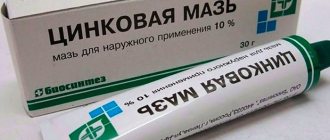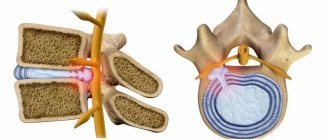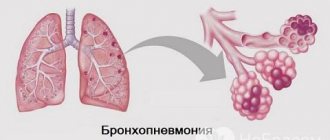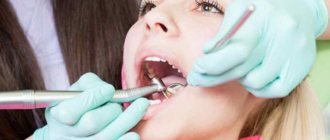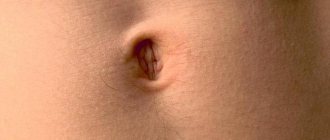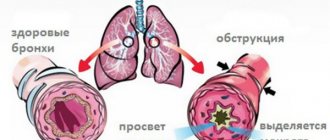How does the remaining umbilical cord heal?
Special clamps or a special ligature with a bandage are applied to the umbilical cord stump.
Many parents are interested in whether their baby’s belly button will be tied beautifully. Previously, in ancient times, the umbilical cord was actually tied with a knot so that there was no bleeding, from which the child could die, but today it is simply clamped with special surgical threads or staples. The umbilical cord remnant or stump gradually mummifies and falls off on the 4-5th day. Sometimes in maternity hospitals it is cut off on the 2-3rd day, but the method of tying the umbilical cord does not in any way affect the further shape of the navel and its appearance, along with the color of hair and eyes - a genetic feature of the child. Sometimes children can also develop a so-called skin umbilicus - in this case, the skin on the abdomen still inside the mother’s belly passes to the area of the umbilical cord.
Regardless of the method of dressing and processing, it must be properly cared for. The fact is that an open wound forms at the site of the falling umbilical cord - and this is always a risk of infection. You will initially be introduced to processing techniques in the maternity hospital; then at home you will do it yourself, twice a day - in the morning, after waking up, and in the evening, after bathing.
For processing, it is necessary to prepare in advance cotton pads or balls, cotton swabs, 3% hydrogen peroxide, an alcohol solution or any antiseptic (brilliant, potassium permanganate, alcohol chlorophyllipt), except iodine. Until the navel stump falls off, it is treated with alcohol and hydrogen peroxide alternately. Then, when the stump has disappeared, the wound must be treated more carefully twice a day, and there is no need to be afraid that the baby will be in pain, it may only sting.
Treatment with folk remedies
There is another effective approach to treating umbilical hernia in newborns at home, this is the use of traditional medicine and the knowledge of our ancestors.
Patch
After complete healing of the umbilical wound, you can, after agreement with your doctor, apply a patch to the navel area, which is specially designed for this and is available at the pharmacy. The hernia is first repaired, then the specialist applies a plaster. At the end of the ten-day period, the surgeon removes it. Thus, three courses of treatment can be carried out.
Important! If after three complete cycles there is no significant improvement in the clinical picture, the method is no longer used.
Applying a coin
This is one of the most famous folk methods for treating umbilical hernia in newborns using a copper coin. It is glued with a plaster or tied to the navel with a bandage. Thus, it turns out something like a bandage. This method of treatment, of course, also has the right to life, but it can provoke irritation of the baby’s delicate skin and an allergic reaction, as a complication infection can be added.
- Another variation of this kind is bean tying.
- Often, many parents, especially under the influence of grandmothers, resort to “charming” the umbilical hernia.
Bandage
For treatment, you can use a special bandage for umbilical hernia for newborns. It is made of environmentally friendly materials, fixes the navel well and does not allow it to protrude. The duration of wearing such a bandage depends on the degree of the disease. It is recommended to periodically consult a doctor.
Oatmeal
There are a lot of folk recipes that use such remedies as, for example, freshly brewed oatmeal as a medicinal drug. A compress is made from the warm mass and applied to the baby’s stomach for up to 1 hour.
- It is proposed to make cakes from clay and also use them as an external remedy.
- Decoctions are prepared from oak bark, fern and knotweed.
All these folk remedies aimed at curing umbilical hernia in newborns are still widely known and often used. I would like to note that these recipes owe such popularity to the fact that in 90 percent or more of cases, congenital umbilical hernia is cured by the age of 6 months - 1 year.
You can use folk recipes to alleviate the symptoms of an umbilical hernia only after consulting a doctor. They should serve as a complement to the main treatment and careful monitoring of the little patient.
Why do babies have a protruding belly button?
The most common causes of an umbilical hernia include:
- vitamin D deficiency (with rickets);
- severe degree of prematurity;
- insufficient fusion of the umbilical vein;
- low weight of the child with varying degrees of malnutrition;
- The abdominal anterior wall has an irregular structure.
Umbilical hernia in most cases occurs in weak and premature babies.
The fact is that their abdominal muscles are weak and they are not able to close the open ring formed in the navel area. If the hole is not closed by muscle tissue, the small intestine begins to leak into it. Prolonged crying, colic, and constipation can also trigger the formation of a hernia.
With prolonged screaming or during difficult bowel movements, intra-abdominal pressure increases. In case of underdevelopment of the abdominal wall, a hernial protrusion can be observed over time. When looking for the cause of a hernia, one should not exclude hereditary predisposition.
If one of the child’s parents has encountered this problem at various stages of life, the likelihood of the child developing pathology increases several times.
The contents of the hernial sac are different in each case. As a rule, it is filled by part of the greater omentum or a loop of intestine. Some parents are sure that a hernia in babies occurs due to the fact that the child’s navel was tied incorrectly.
This theory is wrong. Numerous studies have confirmed that hernia is caused by internal anatomical processes.
Protruding navel
Infants' navel should be dry and clean. In appearance, it is no different from the surrounding tissues. Navels in healthy children may look different. Its shape depends on the characteristics of intrauterine development.
Conventionally, it is customary to distinguish the following types of navels:
- convex;
- arcuate;
- almond-shaped.
A three-month-old baby's belly button may stick out a little or look like a pit. If there is a sudden change in its shape, you need to consult a specialist to rule out pathologies.
- Rickets, malnutrition - these diseases weaken muscle tone;
- Frequent constipation - the child strains, causing intestinal pressure on the umbilical ring;
- Increased gas formation.
Causes
An umbilical hernia can be either congenital or acquired. Based on this, the reasons for the formation of a hernia vary. The congenital form of the disease is provoked by the following factors:
- Genetic predisposition to weakness of the muscles of the anterior abdominal wall. There is a hypothesis that if one of the child’s parents had an umbilical hernia in childhood, then the risk of it occurring in the newborn increases to 70%.
- Weakness of the muscle tissue of the umbilical ring. Often this pathology occurs during the intrauterine development of the fetus. Under the influence of external factors (chemical, infectious, physical), the formation of connective tissues is disrupted, as a result, the structure of the umbilical ring is not strong enough and is not able to support the internal organs.
In most cases, congenital pathology manifests itself in the first month of life. The method of cutting the umbilical cord and applying an umbilical staple has no effect on the formation of a hernia.
The causes of acquired umbilical hernia are:
- Hypotrophy, rickets (diseases provoke a decrease in muscle tone).
- Flatulence, colic, constipation, and strong crying of a child increase intra-abdominal pressure, which negatively affects the healing of the baby’s umbilical ring.
- Obesity;
- Early adoption of a vertical position (the child stood on his feet too early and began to walk).
The acquired form of hernia occurs during the first year of a baby’s life and may have no apparent cause. Only after a complete examination by a pediatric surgeon and consultation with a pediatrician can the provoking factor be determined.
So - let's handle it correctly
Before treating the wound, you need to prepare everything you need so that after the procedure begins you will no longer be distracted by trifles and do not go looking for something forgotten. Remember, a child should not be left unattended on a pencil case. Wash your hands thoroughly before starting the procedure.
Using a pipette or a dropper from a bottle of hydrogen peroxide, drop the solution several times onto the wound area - usually a foam forms at the wound site. This foam with the remaining crusts from the wound must be carefully removed and the wound must be completely cleaned of its contents. If not all of the crusts come off the first time, you can re-drop peroxide and clean them off.
Then you need to carefully examine the wound to see if there is any pus or suspicious discharge there. Then thoroughly wipe the wound with a dry cotton swab or a stick, after moistening the cotton wool in an antiseptic, treat the edges of the wound and the skin around the navel with the solution, without touching the wound itself. You should not use too much disinfectant around the navel, as this may prevent you from noticing skin changes that occur due to various problems.
In addition, you need to be very careful with solutions of iodine and manganese. They can cause burns and must be diluted correctly. No bandages or plasters are applied to the umbilical wound, and if the outcome is favorable, the wound will heal on its own in 7-10 days. While the umbilical wound is healing, it is necessary to put on the baby a diaper with a special notch in the navel area, or tuck the edge of the diaper so that the elastic bands do not rub the wound. It is necessary to bathe the baby while the wound is healing in a slightly pink solution of potassium permanganate.
How does a doctor determine the presence of an umbilical hernia?
Sometimes parents mistakenly mistake an anatomical feature of the child for an umbilical hernia - a protruding navel, protruding 1-2 cm further than the abdomen. Above, we have already mentioned the main distinguishing feature of an umbilical hernia - a volumetric protrusion in the navel area.
Its diameter ranges from one to ten centimeters. If the child lies on his back, the protrusion decreases or disappears altogether.
Only a pediatrician can diagnose an umbilical hernia; in the future, he will refer the child to a surgeon. An examination by a surgeon will determine what exactly is located in the hernial sac. This could be a loop of intestine or adipose tissue.
During a visual examination, the surgeon chooses a method of treating the pathology. To exclude possible complications, he may prescribe a detailed examination. If your child is scheduled to undergo an X-ray, ultrasound examination of the abdominal organs, or take blood tests, be sure to do so.
Symptoms of the onset of a hernia
Umbilical hernia is one of the most common defects in infants and young children. If an umbilical hernia has already run in the family, the likelihood of a recurrence increases. But it is important to be able to identify an umbilical hernia, and not confuse it with another disease or just fat.
In newborns and infants, the muscles in the umbilical region have not yet fully fused and strengthened, and through the gaps in the connective tissue, the internal organs of the intestine can turn outward without damaging the skin.
Concept of hernia
Causes:
- with improper development still inside the mother’s tummy, when the abdominal wall has not formed properly
- in case of improper tightening of the umbilical cord or even if an infection develops
- in case the umbilical ring has not fused or fused incorrectly
- heredity also plays a role
- along with this, strong stress will provoke its appearance (frequent and severe crying, constipation)
Initial stage of hernia formation
. Main symptoms for home diagnosis:
- In most cases, an umbilical hernia in children does not cause discomfort. Only external signs indicate an umbilical hernia: a soft protrusion near the navel. It can be of different shapes and sizes.
- In addition, it is not visible all the time, but more often when the abdominal muscles are tense. This bulge often goes away at night when the baby's abdominal muscles relax. When stressed, for example during screaming, the bulge becomes larger.
- A particularly protruding hernial sac is a typical sign of an umbilical hernia.
Outside the ring
Characteristic signs to independently determine an umbilical hernia in a child:
- The presence of a bulge in the navel area. It can be round, oval, small or large - on average, from 0.5 to 3-4 cm
- The bulge is quite soft and most often painless
- Not always, but more often asymmetrical. Many parents panic when they see small bumps near the navel, especially in the lower part (pictured below at number 1). This is not a hernia, but just fat in the baby!
- The skin in the navel area may become slightly bluish if the intestinal loops are protruding, or reddish if the omentum/liver is protruding. Can remain completely without color changes!
- Under the bulge you can feel a wide umbilical ring, which is a burst circle
- Easily retracts inside with a characteristic pop and returns back when intra-abdominal pressure increases
Let's not panic ahead of time!
Knowing the main signs, you can now easily identify an umbilical hernia in a baby yourself.
- When a child screams, laughs, coughs, sulks or cries, a lump becomes visible - usually up to 5 cm maximum. If it is more, we urgently go to the hospital. Less than 0.5 cm - nothing to worry about, but don’t forget to watch.
- An umbilical hernia without tension looks like a small hole surrounded by a muscle ring located at the navel. But more often, a bulge forms in the navel area, through which the lower tissue is squeezed out. Therefore, this protrusion near or in the navel itself is noticeable to the naked eye.
Umbilical hernia in a newborn
- If you want to be even more sure that you have a hernia, you don't have to see a pediatrician or surgeon right away. You can examine the child yourself at home by palpation. To do this, place your baby on his back and choose a time when he is in a good mood. When he screams, we don’t examine or touch anything. Lightly press this bulge with your fingertips. If it is a hernia, it easily yields and is inserted into place into the abdominal cavity! At the same time, you may hear a gurgling or squelching sound.
- You can also feel this ring around the hernia yourself.
- If the protrusion is large, but does not move into place on its own with a slight push, this may indicate a complication.
Slight bulge
- Very often, young parents are so worried about their baby that they constantly look at him. And it happens that the so-called “cutaneous navel” is considered a hernia. But in fact, this is just a feature of a particular child, and not a hernia. If in doubt, consult your pediatrician. Above we have attached a photo of a normal baby navel.
- The second issue to consider is restlessness and constant crying. Firstly, a hernia does not hurt and often does not bother you. It can hurt in case of physical activity or strong tension of the abdominal muscles! Secondly, it does not cause colic! But flatulence or constipation still do not have the best effect on it, and sometimes can act as additional symptoms.
We also recommend reading “How to treat an umbilical hernia in children?”
Let's weigh it!
Most often, babies are already born with an umbilical hernia. The reasons may be:
- Features of the placement of internal organs of newborns;
- Weakness of the ligamentous apparatus and abdominal wall.
This pathology is most often caused by unfavorable factors during pregnancy or heredity.
If during pregnancy a woman suffers from infectious diseases, then under the influence of harmful substances that enter her body, a delay in the development of the fetus may occur.
In such cases, a child is often born with underdeveloped connective tissue, weakened muscles and ligaments. This is the main cause of hernia in premature babies.
- Expansion of the umbilical ring;
- Protrusion of internal organs, which is almost invisible in a calm state in a position on the back and increases significantly when the baby either cries, or strains, or is simply in an upright position.
- The most effective treatment method is to frequently place the baby on his tummy - 2-3 times a day before feeding for 10-15 minutes. The surface on which you place the baby should be hard, and his attitude during this procedure should be only positive. The baby should actively move, move his legs and arms, and under no circumstances cry, and at this time you give him a light massage of the back, the whole body, stroke him, talk to the little one.
- Massage and gymnastics are excellent means of getting rid of this ailment. A specialist should familiarize you with the techniques of such treatment.
The set of exercises that you will perform on the recommendation of a specialist can be supplemented with the following simple steps.
Place your thumb and index fingers to the right and left of the baby’s navel at a distance of 2–3 cm and make 10 gentle rhythmic presses, pointing the fingers towards each other. The baby should not experience pain or discomfort.
Then place your fingers above and below your navel in the same way. And again do 10 presses. Then, close your fingers and make clockwise circles around your navel 10 times. These exercises must be repeated before each feeding, after laying on the tummy. They will strengthen the ligaments and muscles of the newborn.
The reasons for the expansion of the ring and the formation of a hernia in infants and adults differ. In children, the main factors causing pathology are:
- Incorrect development of the anterior abdominal wall or underdevelopment of fibers. This condition is caused by various reasons, including infections in the woman, constant exposure of the mother's body to toxic substances, or overexertion during pregnancy.
- High pressure inside the peritoneum. In this case, the hernia is not considered a congenital pathology; it is formed in the first year of life (most often a few weeks after birth) due to intense, frequent crying and screaming.
- Weakness of the umbilical ring and connective tissue dysplasia. These are congenital pathologies that may appear later than a year after birth.
In adults, divergence of the umbilical ring and the formation of a hernia are due to a wide range of reasons:
- difficult childbirth and pregnancy;
- carrying a child multiple times;
- multiple pregnancy;
- operations localized in the peritoneal area;
- injuries of the abdomen and anterior abdominal wall;
- adhesions and tissue scarring;
- prolonged cough;
- constipation and straining during bowel movements;
- excessive physical activity;
- ascites (often occurs with cirrhosis);
- obesity or sudden weight loss of 10 kilograms or more;
- decreased muscle tone due to lack of physical activity.
There are factors that contribute to excessive divergence of the umbilical ring, followed by the formation of a hernia. Similar disorders are observed in women who become pregnant after 35-40 years of age. Some professions can provoke the disease, for example, playing wind instruments.
Only a doctor can determine ring discrepancy in a newborn or adult. The pathology is not always immediately accompanied by a symptom such as navel prolapse.
A normal umbilical ring has a fairly high density. It is narrow, and if you insert a finger there, it will immediately hit the wall without penetrating into the abdominal cavity. With the development of pathological processes, the ring becomes much wider, and the tone of the navel decreases. The tip of the index finger passes through it easily. An umbilical hernia is accompanied by the following symptoms:
- pain – does not occur in all cases, but if it does, it can radiate to the navel, lower back and along the spinal column;
- protrusion always occurs with a hernia, but may be absent if the ring has just begun to expand;
- in the first stages, the prolapsed sac is easily repositioned and has a soft consistency;
- the size of the hernia depends on the duration of the disease.
Surgical treatment
Surgery is resorted to in cases where conservative treatment does not help, the hernia is constantly increasing in size, or strangulation has occurred. The main indications for surgical intervention are:
- trunk-shaped protrusion;
- pain or discomfort;
- the hernia appeared in the child after 6 months;
- hernia more than two centimeters in diameter;
- the child has reached the age of five.
The operation is performed after three years, with the exception of severe complications and the possibility of strangulation, in which case surgical intervention may be necessary from the first months of life. In childhood, the period of postoperative recovery is insignificant, muscle tissue is quite elastic and can be easily corrected.
The surgery takes place under general anesthesia. The doctor makes a small incision below the navel, realigns the protruding organs and excises the hernial sac, followed by suturing of the tissue.
The laparoscopic method of surgery is more gentle for the child. The procedure itself lasts no more than fifteen minutes, and there is practically no recovery period. After the operation, the child can go home the same day; only in rare cases is it recommended to stay in the hospital for 1-2 days for observation.
Healing time of the umbilical wound
The healing of the navel in babies occurs differently. In some newborns this process takes 10-14 days, in others it takes about a month. But normally, a baby’s navel should retract within 3-4 weeks.
Healing of a wound on the abdomen of a newborn child occurs according to the following scenario:
- On the first day, a part of the umbilical cord is attached to the navel, pinched with a clamp or clothespin.
- Over the course of 5-10 days, the umbilical remnant of a newborn baby should dry out and fall off.
- After part of the umbilical cord falls off, a deep depression remains on the abdomen. It is considered normal that blood or ichor will ooze from the surface of the wound for 2-3 weeks.
- The navel can take up to a month to form. During this time, it is completely healed.
With a well-healing navel, there is no increase in temperature, the skin around the navel does not change in color and is not hot to the touch, there is no elevation of the skin and the navel area, there is no smell from the wound or discharge. Sometimes, about 3-7 days, at the site where the umbilical cord stump falls off, the wound may heal - this is acceptable and requires regular treatment. If bleeding from a wound continues for more than 10 days, this is a reason to contact a surgeon or local pediatrician.
Healing of the umbilical wound can be difficult if there is excess granulation (scar) tissue. In this case, the growth of blood vessels and connective tissue in the wound occurs, interfering with active healing and promoting bleeding. This pathology of the umbilical wound is usually called fungus or umbilical granuloma.
Surgical treatment of pediatric umbilical hernia at the Laser Medicine Center
or why you shouldn’t be afraid to go to a pediatric surgeon
If the time allotted by nature to your baby’s health for self-healing is coming to an end, if all your conscientious efforts to help your child cope with this harmless pathology have not yielded results, then you should not hesitate and gather your courage and make a decision on surgical treatment of the hernia.
Please note that the uniqueness of a child for parents does not apply to his illness for a doctor. If a pediatric surgeon has several dozen operations to repair an umbilical hernia, then his professional experience is a sufficient guarantee of the success of the operation. When you are dealing with a doctor who has performed hundreds of similar operations, the child’s parents have an objective reason to be completely confident in the successful surgical treatment of their child.
Dear Parents.
You can get qualified help regarding the treatment of an umbilical hernia, as well as hernial protrusions of other origins, in the pediatric surgery department of the multidisciplinary clinic “Laser Medicine Center”.
We widely use modern effective treatment methods to achieve positive results. The department is equipped to the most modern standards, so your stay in the hospital will be as comfortable as possible.
What does it look like?
An umbilical hernia can be seen with the naked eye. If the tissue around the belly button protrudes when your baby cries, the baby most likely has a hernia. Another obvious sign is that in a calm state, the umbilical ring is unnaturally wide and protrudes slightly above the abdomen.
What does an umbilical hernia look like in a newborn?
In both the first and second cases, the umbilical ring does not converge completely. In this case, the small intestine can be easily felt through the skin. When the tummy is bloated, the hole widens noticeably, and the internal organs protrude even more.
When the baby calms down, the hernia is more difficult to notice. However, even in this case, parents should not let the situation take its course, hoping that the disease will go away over time without professional treatment. The size of the hernia in this case does not matter.
If the pathology is left unattended, a pea-sized hernia will greatly increase in size over time.
Does an umbilical hernia bother your baby?
Much more often this pathology worries parents than the baby himself. An umbilical hernia is formed by intestinal loops; their protrusion is removed inward by light pressure with a finger.
When the umbilical ring is very wide and the hernia is large, parents can see contraction of the intestinal muscles and the movement of food through it. This frightens them extremely, but for a child this feature does not cause any inconvenience.
Infants very rarely experience a strangulated hernia; for this reason, they do not experience any pain. However, children diagnosed with an umbilical hernia are more weather dependent than their peers who do not have such a pathology.
The presence of a hernia is often accompanied by bloating, causing anxiety and crying of the baby. In some cases, an umbilical hernia, which does not cause any trouble for the baby, should be considered only as some kind of cosmetic defect.
Possible problems
The umbilical wound can hurt, fester and take a long time to heal. In young children, peculiar protrusions may appear in the middle of the abdomen. All this refers to pathologies that require special treatment.
Omphalitis
Inflammation of the umbilical wound of a newborn
A disease caused by a bacterial infection that causes inflammation of the tissues of the umbilical wound. Omphalitis develops due to improper care of the baby or against the background of weakened immunity. Tissue inflammation develops through too active wound treatment or, conversely, in its absence.
With a simple or catarrhal form of the disease, the umbilical remnant will not fall off for a long time. The resulting wound becomes wet and will not heal. Bloody, serous-purulent or clear discharge constantly oozes from it. The skin around the navel turns red. At the same time, the child feels good.
In some cases, the umbilical wound dries out and becomes covered with a thick crust. This leads to the accumulation of purulent discharge and the development of complications. The most common of them is fungus. It is characterized by the appearance of granulations at the bottom of the navel.
The most dangerous is the phlegmonous form of omphalitis.
The phlegmonous form of the disease is very dangerous. Without special treatment, the infection spreads throughout the child's body, which can be fatal. With the development of phlegmonous omphalitis, the following symptoms are observed:
- the appearance of intense purulent discharge;
- the navel may protrude slightly;
- the skin on the abdomen may darken and become hot to the touch;
- increased body temperature;
- The child is not feeling well.
Umbilical hernia of a newborn
If a large ball comes out from the baby’s navel while crying, you can suspect the development of a hernia. It is characterized by the protrusion of part of the intestine or omentum through the umbilical ring. At rest, the defect is drawn inward and remains externally invisible. If you press your finger on the navel, it falls into the abdominal cavity.
The size of the convex formation varies from 0.5 to 5 cm. The reason for its appearance is the congenital weakness of the umbilical ring. When following the doctor's recommendations (massage, strengthening the abdominal muscles, eliminating constipation), the hernia disappears without a trace by 5-6 years. If this does not happen, surgery is prescribed.
In rare cases, a hernia in children is complicated by strangulation. Its development is indicated by the appearance of a ball near the navel, which may turn blue or turn brown. In this case, the child will cry a lot from pain. Treatment of infringement occurs only with the help of surgery.
Umbilical fistula
The pathology is characterized by the connection of the umbilical ring with the small intestine or bladder. The formation of fistulas occurs due to the characteristics of the intrauterine development of the child. Normally, every baby has choleretic and urinary embryonic ducts. The first is necessary for feeding the fetus, and through the other, waste products are excreted. By the time the baby is born, these ducts close. If this does not happen, a fistula forms.
When the ducts from the bladder are fully open, the navel remains constantly wet. Urine oozes out of it, which can even squelch. With an incomplete fistula, the color of the skin near the navel changes, and a secretion with an unpleasant odor is released. When the bile duct opens, partial removal of intestinal contents occurs. It is visualized on the surface of the navel and provokes the development of a bacterial infection.
Bloody discharge from the belly button may be a sign of infection
Parents may notice a number of other pathologies in their child:
- Heavy bleeding. The surface of the umbilical wound quickly dries out and becomes covered with a thick crust. If hygiene procedures are performed carelessly or when putting on clothing, tissue injury may occur. To stop bleeding and prevent infection of an open wound, it is recommended to treat the skin with peroxide or any other antiseptic.
- Entry of a foreign body into the umbilical wound. This can be an ordinary thread or hair. To remove them, the wound must be washed generously with peroxide. If the problem cannot be resolved in this way, it is recommended to consult a surgeon.
- Redness of the skin around the navel without signs of inflammation. This problem is more common in older children who have explored their bodies. Inflammation may occur due to food or contact allergies.
Sometimes problems arise with the navel - dangerous and unpleasant diseases that you need to know about in order to recognize and cure them in time. One of the most dangerous diseases for a baby is inflammation of the navel, or omphalitis. Omphalitis is an inflammation of the skin with adjacent subcutaneous tissue in the navel area; often the inflammation also spreads to the area of the umbilical vessels, which can cause arteritis - inflammation in the arteries or phlebitis - inflammation in the veins in the navel area.
What treatment is prescribed for an umbilical hernia?
Most often, no special treatment is prescribed for the presence of an umbilical hernia. There are many cases where pathology with a small umbilical ring defect (less than 1.5 cm) disappears without any external interventions. The disappearance of the hernia can occur by one to three years.
If by the age of 5-7 years the umbilical hernia remains in place, they resort to surgical intervention. A timely, meticulously performed operation makes it possible to eliminate the pathology without any cosmetic defects and subsequent relapses of the disease, which are extremely rare.
Girls are recommended to have surgery so that the hernia does not interfere with pregnancy and childbirth in the future. For boys, operations are most often performed due to strangulation. An umbilical hernia in a teenager in the strangulation stage can manifest itself as nausea, pain, increase in size, and lightening of the skin color at the site of the protrusion.
When the umbilical ring defect has a large diameter, it is impossible to hope for its spontaneous closure. In such situations, surgery is prescribed already at the age of 3-4 years.
Forms of omphalitis
There are three forms of omphalitis - simple, phlegmonous and necrotic. In the simplest, most frequently occurring form (it is also called a weeping navel or catarrhal omphalitis), manifestations occur at home. Usually, by the time of discharge, on days 4-6, the navel is under a bloody crust, which, under normal conditions and proper care, gradually heals by 10-14 days, it is completely epithelialized - that is, tissue is formed there that lines the skin.
When a weeping navel develops, the healing of the umbilical wound slows down, serous, sanguineous or purulent (yellow-green) and even bloody discharge appears in the wound. In the area of the umbilical ring, redness may be noted, and the wound periodically becomes covered with a crust, under which discharge from the wound accumulates, not abundant in nature.
So – the key signs of simple omphalitis (wetting navel):
- – the umbilical wound takes a long time to heal, longer than 2 weeks;
- – discharge from the umbilical wound is scanty – ichor, purulent or bloody;
- – redness of the umbilical ring (not always).
More severe necrotic and phlegmonous forms are manifested by copious purulent discharge and sharp redness around the navel, the skin is hot to the touch and dense, there may be ulcers of the umbilical wound, and pus is released when pressure is applied. In this condition, general well-being is disturbed - the temperature rises sharply, intoxication and changes in the blood are detected, the child requires active and, often, inpatient treatment.
Development mechanism
The abdominal cavity is limited on all sides by walls. When the pressure inside increases, the contents of the cavity (intestinal loops, greater omentum) tend to “crawl out” through the weakest points of the wall. Such natural weak points of the anterior wall of the abdominal cavity include the umbilical ring. When intra-abdominal pressure increases, the contents of the cavity rush into it, forming a characteristic protrusion - a hernia. A hernia is a pathological anatomical formation, which consists of the following parts:
- Hernial sac - the walls of the protrusion, which are usually formed by the parietal (parietal) layer of the peritoneum.
- The hernial orifice is an opening through which contents communicate with the abdominal cavity.
- The contents of the hernia are most often represented by loops of the small intestine or tissue of the greater omentum.
The pathogenesis of the formation of an umbilical hernia in congenital pathology, as the main mechanism, includes the primary weakening of the tissues of the umbilical ring, while the hernia is formed against the background of a slight increase in intra-abdominal pressure. The acquired origin of a hernia is characterized by the formation of a protrusion against the background of a significant increase in intra-abdominal pressure. In this case, the strength of the tissues may not be changed or reduced to a small extent.
Methods for treating umbilical hernia in children
After
the navel seems to stick out a little forward when the child screams and pushes. At the initial stage of development of the disease, the navel can be easily moved back into place. In this case, the baby will not have a negative reaction.
However, as the baby grows, the hernia will also increase in size. For this reason, swelling appears in the navel area. In any case, the final diagnosis can only be made by a doctor during an examination of the child upon reaching the age of one month.
In newborn boys, an inguinal hernia is more likely to appear, and in girls - an umbilical hernia. The appearance of an umbilical hernia is signaled by protrusion of the navel. As for an inguinal hernia, it is a tumor-like neoplasm that appears in the groin area.
It is distinguished by density and pain when touched. In some cases, an inguinal hernia in boys extends into the scrotum. This disease is treated surgically.
Parents whose child has been diagnosed with an umbilical hernia should know exactly how this disease is treated. It should be noted that quite often hernias heal on their own. The fact is that as the baby grows, the abdominal muscles become stronger, due to which the ring narrows, and the hernia gradually closes without surgical treatment.
In order to avoid surgical intervention, it is necessary to provide the child with appropriate care. Experts recommend placing the baby on his stomach before each feeding.
In this case, the baby should lie on a hard and level surface. This can be a changing table or a regular table covered with a diaper.
The baby can be laid out only after the umbilical hernia has completely healed. To prevent and treat umbilical hernia, abdominal massage is often prescribed. It is advisable that it be carried out by an experienced specialist. However, parents can perform simple manipulations on their own.
It is important to know that a massage course can be carried out from the second week of a child’s life. In this case, the umbilical wound should heal well and not cause concern to the baby. Parents can perform clockwise stroking movements and also stroke the oblique abdominal muscles. It is important that all movements are light and bring pleasure to the baby.
During the massage, the child should not cry. Otherwise, the procedure must be stopped.
It is important to note that with the development of an umbilical hernia, in rare cases, the intestine is pinched by the muscles. This process is dangerous and can lead to the development of serious diseases. Therefore, if you suspect a hernia, the baby should be shown to a pediatrician.
The bandage is an elastic belt equipped with a small pad. It acts as a hernia limiter. Eco-friendly, hypoallergenic materials are used for the production of bandages.
The products are easy to wash and are resistant to wear. The bandage provides optimal pressure in the navel area, thus preventing further protrusion of the hernia.
Thanks to this effect, the umbilical ring closes much faster, and the likelihood of strangulation becomes minimal.
A bandage for babies can only be used after the umbilical wound has completely healed. Depending on individual characteristics, the product can be used for more than a year.
Hernia concept
We offer introductory symptoms to identify a pinched umbilical hernia:
- Sometimes the intestines become trapped in an umbilical hernia. This is called a strangulated hernia. When this happens, the baby will usually experience a lot of pain and the lump may be hard and red. Urgent medical examination is necessary to repair the hernia in time to prevent possible damage to the intestines.
- If the child does not experience a painful reaction when touching the arch, the arched bursa can be lightly pressed on the abdomen. If the newborn does not show signs of pain, does not cry or grimace, then everything is fine.
- A sign of possible problems, even in the future, will be pain in the child's abdomen, especially after active movements. For example, you did morning exercises for your child, and he starts crying a lot. This is confirmation that you need to see a specialist.
- Sometimes additional ultrasound examination may be required. It serves to monitor the progress of an umbilical hernia. Especially if the bulge is relatively large and may contain loops of intestine, ultrasound is necessary for further examination.
Pinching!
Visit your doctor in the following cases:
- The bulge becomes painful
- Vomiting and/or diarrhea occurs when the bulge is present
- The belly is getting bigger
- Body temperature rises
- The bulge becomes more swollen, discolored, or bluish-red
- The bulge no longer hides back into the abdominal cavity
If an umbilical hernia does not go away on its own by age three, it should be surgically repaired before preschool age. The operation is usually performed from the age of 5, but much depends on the situation. If surgery is not performed in time, the risk of pinching increases. In girls, an existing umbilical hernia can create problems with later pregnancy.
In children from birth to 1 year, active expectant treatment is used, which includes:
- constant monitoring of the condition of the navel;
- use of support bandages;
- operation if containment measures are ineffective.
In adults and older children, the only method of effective treatment for umbilical hernia is surgery. With its help, the surgeon isolates the hernial sac and returns its contents back into the abdominal cavity. Then a special mesh is installed to restrain the hernial orifice. The operation is performed under local or general anesthesia, depending on the complexity of the patient’s condition.
The rehabilitation period is 6 months, the first weeks must be kept in bed.
Treatment regimens
Doctors recommend treating pathology using conservative methods. These include:
- Special gymnastics. A set of exercises helps strengthen the muscles of the peritoneum and the navel ring. The main condition of the course is the absence of absences from classes.
- Abdominal massage. It must take place in a medical facility. Less often, doctors recommend that parents do it themselves.
- Applying a bandage (plaster) to support the navel and prevent protrusion of the ring.
- A gentle diet and prescription of drugs that control stool.
Surgical treatment is used to prevent rupture and strangulation, as well as in case of complications. In most infants, hernias are eliminated after sufficient strengthening of the abdominal muscles, usually in 1-2 years. If this does not happen, at 3-5 years of age a planned operation is performed - suturing the umbilical ring.
Home non-surgical therapy methods
Exercise therapy and massage are recommended to begin immediately after the navel wound has completely healed. Parents place the baby on the tummy before feedings, and it is also recommended to do gymnastics on a fitball and light body massage. It is prohibited to massage the area of the umbilical ring and the abdominal muscles without prior training from a doctor.
As a treatment and prevention, placing the baby on his stomach is recommended for 7-12 minutes every day.
Massage technique for umbilical hernia in newborns:
- Make circular movements in a clockwise direction for a minute. Repeat in the opposite direction.
- It is easy to press down the bulge of the hernia until it disappears. Press it in with your finger and twist it clockwise.
- Gently massage the abdominal muscles.
No less effective for hernias is a bandage - a special bandage/plaster that compresses the edges of the umbilical ring. The course of treatment lasts 1-3 weeks.
Another important rule for parents is to carefully monitor the child’s stool and nutrition. In order to prevent constipation, vegetables rich in fiber are introduced into the baby’s diet, and, as prescribed by a doctor, lactulose and mild laxatives. Walking, bathing and microenemas alleviate the condition of the newborn.
Traditional healers suggest using compresses with the juice of sauerkraut and oatmeal, and clay cakes on the navel area. After them, it is recommended to place a slice of raw potato on the bulge. Another popular method is to place a crumb of an old copper coin smeared with iodine on the stomach.
It is worth keeping in mind: using exclusively home remedies and patches without consulting doctors often leads to complications.
Surgical intervention
The non-surgical method frightens parents less than surgical intervention, but there are cases when it cannot be avoided. Indications for elective surgery are:
- the size of the formation is more than 15 mm and the continuing growth of the hernia;
- high risk of injury, infringement;
- manifestation of the defect in a child older than six months or his growth at the age of more than 1-2 years;
- trunk-shaped umbilical hernia;
- age more than 3-5 years;
- discomfort in everyday life.
Emergency intervention is carried out in case of rupture of the skin and strangulation of the intestine.
The surgery is performed under general anesthesia. During it, the doctor makes an incision in the skin and muscles below the navel, sets the intestine and peritoneum, and then sutures the hernial sac. After strengthening the connective tissue and muscle wall, sutures are placed on the wound. Laparoscopic surgery lasts 15-20 minutes, and the hospital stay is no more than 3 hours. There is no need to remove the suture and take analgesics after a low-traumatic intervention.
Recovery after surgery
After the operation, the child must remain in the hospital for some time. For 2-3 days, if the intervention was not low-traumatic, it is necessary to observe bed rest, then you will need to wear a bandage. You should choose a diet that is as light as possible, semi-liquid and rich in fiber, it will help avoid constipation.
Sutures from the operated area are removed 6-7 days after the intervention, but it is recommended to wear the bandage for another 1-2 months.
An umbilical hernia is not a dangerous pathology and in most cases corrects itself. If a child receives high-quality prevention of intestinal protrusion and is regularly examined by a pediatrician, then parents have no reason to panic.
Diagnosis of the disease
The surgeon can recognize an umbilical hernia at the first examination, as well as determine the presence of an enlarged umbilical ring. The patient cannot independently diagnose these pathologies.
A simple form of omphalitis can be cured at home, under the supervision of a doctor. The remaining forms are treated only inpatiently, in the neonatal pathology department. At the same time, it is important to properly treat the navel and not allow purulent or any other contents to accumulate under the crust, so it is necessary to treat the wound in a timely manner.
In simple forms, the wound is first treated with a solution of hydrogen peroxide, and then with 70% alcohol, a solution of furacillin, chlorophyllipt or dioxidin - and so on at least 3-4 times a day, otherwise inflammation and infection cannot be defeated. When treating a wound with peroxide, you must use a sterile pipette and carefully remove all crusts and foam.
Repeat the treatment until the hissing stops, then wipe the bottom of the wound dry. Using a cotton swab dipped in an antiseptic solution - brilliant green, fucorcin or chlorophyllipt - rub (i.e. spot-smear) the wound and its entire bottom, slightly capturing the skin around it. Each operation is performed only with a new stick.
Other forms are treated with antibiotics and surgical treatment of the wound. If there are indications, anti-staphylococcal immunoglobulins can also be administered. In addition, physiotherapy procedures are prescribed - UHF, laser and others.
To avoid problems with the navel, careful and regular treatment is necessary from birth until the wound is completely healed.
Traditional methods
Traditional medicine recipes can not only stop the progression of the disease and eliminate symptoms, but also completely remove the protrusion. The main components of tinctures and compresses are medicinal herbs; they do not have a harmful effect on the child and do not harm other organs.
Hernia compress
♨ Take a hernia plant and steam it with boiling water. Allow the tincture to cool to room temperature (it should not be hot or too cold). After this, apply moistened gauze to the sore spot. Keep it for half an hour. You can repeat it daily.
Honey compress
♨ To treat small hernial protrusions, a honey compress is used; regular use of this method guarantees the patient’s complete recovery.
For the procedure, you need to take one tablespoon of honey and lubricate the area around the navel. Place a clean sheet of paper on top and wrap it with a towel. Leave the compress until the morning. In the morning, rinse off the remaining honey with warm water and pat dry with a dry towel. Draw a circle around the navel using a cotton swab dipped in iodine. In the evening, repeat the honey compress.
This treatment method should be used daily before the child goes to bed until complete healing.
Note!
It is first necessary to check the reaction of the child’s skin to honey.
Cow butter ointment
♨ An equally effective way to treat a hernia is a homemade ointment made from cow butter and propolis.
To prepare it, you need to take 50 grams of butter (you can make it yourself from homemade milk or buy it at the market), melt it in a water bath and pour in one teaspoon of propolis tincture. Before going to bed, lubricate the sore area with ointment and leave overnight. In the morning, rinse with warm water, wipe and make a net of iodine. Since propolis is a honey-containing product, it is necessary to test the skin for allergic reactions.
Conspiracy for umbilical hernia
From time immemorial, our grandmothers practiced a spell to treat an umbilical hernia in an infant. The essence of the ritual is simple and does not require any magical skills; the spell will not only do no harm, but in some cases will help overcome the disease.
The conspiracy should be carried out by the child’s mother or grandmother; they are the ones who have the greatest connection with him and sincerely wish for recovery. You should not resort to the help of strangers, not blood relatives; insincere prayer will not give the desired result. The ritual must be performed on the waning moon. Before and after the procedure, you cannot tell anyone about the conspiracy; when the hernia disappears, then you can tell your loved ones.
In the evening, the mother lightly bites the hernia and says the words: “Hernia, I’m herniaing you hard! I have seven teeth, you have one. I will eat you!" You need to read it three times, after each spit over your left shoulder. You can carry out the conspiracy only once, the results will be noticeable in a few months.


